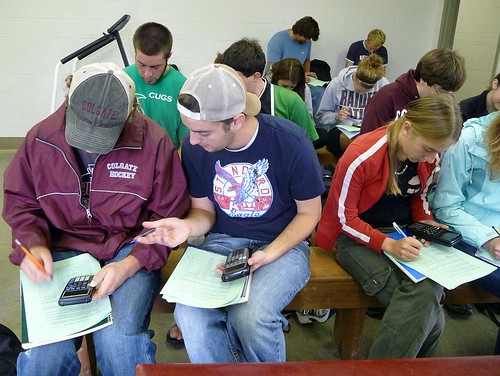![]() (Editor’s Note: This story was written by Kiki Koroshetz ’11
(Editor’s Note: This story was written by Kiki Koroshetz ’11
On a cold and rainy September afternoon, Geology 215 students met with Professor Constance Soja for the second lab of the semester. On this particular Thursday, they gathered under Andy Kerr Stadium, in the visiting team locker room.
The mist outside didn’t seem to dampen Soja’s spirits as she introduced
the lab of the day, “Gridiron Geologic Time.”
The goal: to create a
graphic representation of geologic time, true to scale, on Colgate’s
football field, placing flags as symbols of important geologic events
along the 100 yards.
Under Soja’s lead, the locker room was transformed into a classroom, where students, sitting on benches in groups of three and four, brainstormed major events in Earth’s history. The class discussed the relative timing of events like the Cambrian explosion and the Pleistocene glaciation.
In order to shrink 4.5 billon years of Earth time into 100 yards, the group determined that 1 yard on the field would represent 45 million years, and 1 inch, 1.25 million years. Using this scale, the students reviewed a list of nearly 30 geologic events and calculated their distances from the north goal line, which marked the origin of Earth at 0 yards.
Soja gave each student two flags to place on the football field inside of bottles. Karen Bascom ’12 received “O2 and O3” (the accumulation of oxygen and ozone in the atmosphere) and “prokaryotes” (simple cells), which occurred 4 billion and 3.5 billion years ago, respectively.
After placing the first flag on the white side line, near the north end zone’s 11 yard line, and the second near the 22 yard line, Bascom walked toward the other end zone, where she passed flags marked “algae,” “insects,” and finally, at approximately 99.94 yards (2 inches from the goal line), “first hominid.”
The visual treat of the lab was standing on the top row of the bleachers and looking down at the flags.
The Earth’s earliest events, marked by green flags, were spread out mostly on the north side of the field, and then yellow, orange, and red flags clumped closer together near the south end zone. The red flags marked events that occurred within the last 40,000 years — or 2 inches — such as the birth of art and the Declaration of Independence.
“Standing at the top of the field and seeing how long until anything we are familiar with comes onto the scene is really surprising,” Brittany Hanrahan ’11 reflected.
“We’re living in the last inch of geologic time,” Bascom said. “That really puts everything into perspective.”
After the students picked up the flags, Soja took a group picture and told them to get out of the rain. She was left in the locker room, smiling. “It was a little quirky to use the football field for another purpose.”
But it worked out just right.
